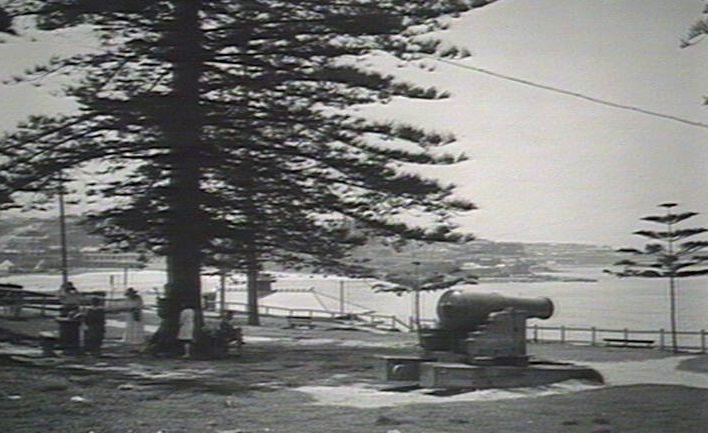
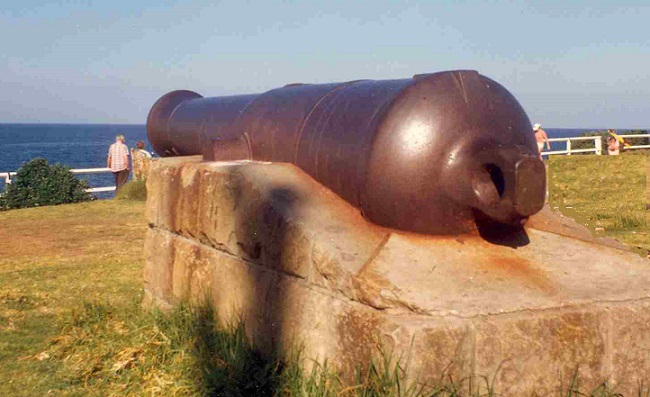
Coogee Cannons in the 1930s (left) and 1970s (right)

Old Coogee Canon now located at Bob Clarke Reserve, Malabar
It appears they also include the sandstone mounts from Coogee
HISTORY | STORIES | BEYOND BLOG & CREATE PEOPLE |
Black Cannons in Dunningham Reserve
A little bit of sleuthing showed that there had been two large black cannons mounted in Dunningham Reserve up until the 1980s. A number of cannons were acquired by the New
South Wales colonial government from Britain in the mid 19th century. These huge black, muzzle loading, 42 pounder cannons, manufactured in 1843 and sited at what was then Fort Macquarie and
now the site of the Sydney Opera House,
became obsolete. In 1904 the obsolete smooth bore guns were offered to Municipalities and Parks as display pieces. As a result of this distribution,
two guns were made available for display at Coogee. These were mounted on wooden carriages. Some accounts say they were both placed on
northern headland in Dunningham Reserve. However, some say there was one on each of the northern and southern headlands, and a contemporary
photograph shows one mounted on the south headland in Grant Reserve. By my memory, in the 1970s the wooden carriages had been replaced by sandstone,
and both were on the northern headland. In 1985 the guns were moved to Clarke Reserve at Malabar and placed next to the War Memorial.



Old Coogee Canon now located at Bob Clarke Reserve, Malabar
It appears they also include the sandstone mounts from Coogee
However, the fact that the guns were only used for display and not military purposes, and that their mounts were at first mobile wooden ones, and later sandstone mounts (presumably installed by Randwick Council) would discount any possibility of a subterranean network of military chambers. There are no tunnels!
Clovelly "Disappearing Gun"
Nearby on the northern Clovelly headland (Shark Point), there was a 9.2-inch (234 mm) calibre breech-loading gun on a hydro-pneumatic mounting installed
in a fortress in 1891. It was a so-called 'disappearing' gun because it could be raised to fire and lowered to reload in its fortified pit. This gun had a range of more than
16 kilometres and could attack warships approaching the harbour or attempting to bombard Sydney offshore. It was decommissioned and eventually the guns
sold as scrap in the post World War II era. For all I know, the remains of the fortress and the underground caverns have been covered up and are still
under the ground at Burrows Park.
Real Tunnels
There is however a major tunnel system under Dunningham Reserve with a striking oval shaped outfall cut into the rock of Coogee's northern headland. Because
of its location, only the most adventurous of beach visitors who are willing to scramble over the rock shelf in front of the tall headland, would ever
get to see it: the Coogee - Randwick Outfall Sewer tunnel system.
If there is a secret network of tunnels under Coogee it would have to be the Coogee - Randwick Outfall Sewer tunnel system. The main tunnel extends from the headland under Dunningham Reserve and then under Dolphin Street. Between Melody Street and Carrington Road, it then heads south-west toward Rainbow and Avoca Streets and terminates at Kensington. A contemporary Sydney Water map seems to indicate a branch sewer tunnel ran north from Dolphin Street up Arden Street towards Clovelly. It is constructed of brick and oviform in shape. It is 6ft by 4ft in dimension and diminishes to 3ft 3 inches by 2ft 2 inches.
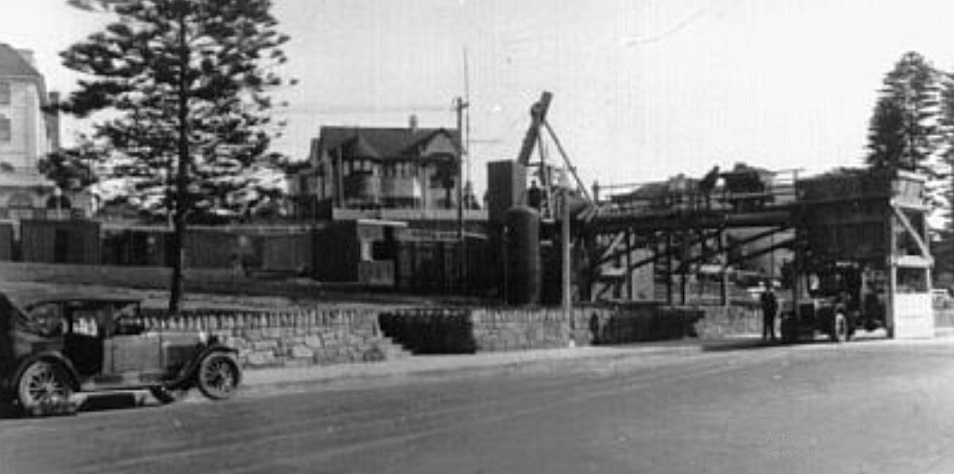
Coogee Sewer Tunnels
The Coogee - Randwick Outfall Sewer tunnel was built by the NSW state Public Works Department in 1889 for Randwick Municipal Council. The council was only able
to raise funds for partial completion of the sewer and the State Government, through its Metropolitan Water Sewerage & Drainage Board (now known as Sydney
Water) assumed responsibility to complete the sewer in 1892. Ownership of the sewer was transferred to the Board in 1902 and branch sewers transferred to
the Board in 1905.
Pollution Complaints
Following complaints from the local community, surf clubs, and beach goers about the pollution that was blown onto the beach by the summer prevailing winds,
a disintegrator was installed at the outfall in 1928. This was a palliative measure until a diversion sewer was connected to the main sewer system
(the Southern and Western Ocean Outfall Sewer) to the Malabar Outfall, was completed in 1936. The Coogee tunnels are now disused, and are now listed on the
NSW State Heritage Inventory.
Exciting Adventure
Coogee Media decided to send me on a bit of adventure and see if I could find the tunnel opening. It was a cold July day, so I rugged up and headed down the
stone steps cut into the rock face to Giles Baths and then turned left on to the rocky platform in front of the headland. Despite wearing sturdy hiking boots, walking over the very uneven
rock shelf was difficult and slippery underfoot. Clearly, doing this could be extremely dangerous in big seas, but thankfully on this day, the sea
was relatively calm. It was slow progress and I slowly moved forward, up and down, over large boulders and fallen rocks. I began
to doubt whether the tunnel opening still existed. But then after about 15 minutes of strenuous hiking, midway along the rock shelf, the opening suddenly appeared.
It was much bigger than I expected - an average sized person could easily stand in the opening. Water still trickled out of the base of the tunnel.
I inched my way in front of the tunnel opening, trying to get the best photos and videos that I could. Once directly in front of the tunnel opening, I was struck by a sudden and oppressive feeling of a jump in the humidity and air pressure. Damp, warm air was being pushed down from the heights behind Coogee. There was a heavy, dank, earthy smell and the temperature seemed to be about 10 degrees celsius higher than the surrounding air. This creation of a micro climate was surprising. As I moved away from the tunnel mouth, I turned to take another photograph and realised the lens on my camera was completely fogged up and had to wait 5 minutes for the mist inside the camera to clear. After returning to the Giles Baths platform, I thought "that is about as exciting as I want to get".
Foolhardy Adventurers
At some stage in the past, a hardy graffitist had ventured about 3 metres inside the tunnel to daub the walls with some street art. To my mind, it would be
foolhardy to try and venture any distance inside the dark, dank tunnel. Exploring urban tunnels maybe foolhardy, but that is exactly what some people do
for recreation.
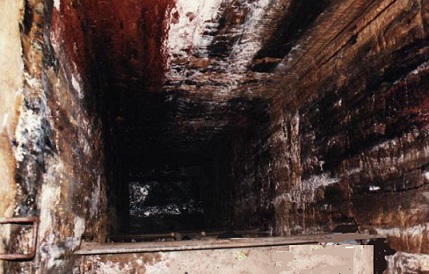
In January 2008, three urban cavers went into the now notorious system tunnels via a manhole in Moverly Road, Kingsford. The tunnels, known as "The Fortress" run deep underground. They are more than two kilometres long and up to 10 storeys high, with slides, balconies, and waves from the Pacific Ocean battering bars across the outlet at Lurline Bay. But sudden torrents of rainwater can rush through them without warning. This is what enveloped the three cavers and eventually trapped them against a grille at the ocean entrance to the tunnel in Lurline Bay. One 27-year-old man managed to escape between the metal bars of the grille and was rescued. But a 25-year-old and 21-year-old woman drowned before Maroubra lifeguards risked their own lives to retrieve their bodies.
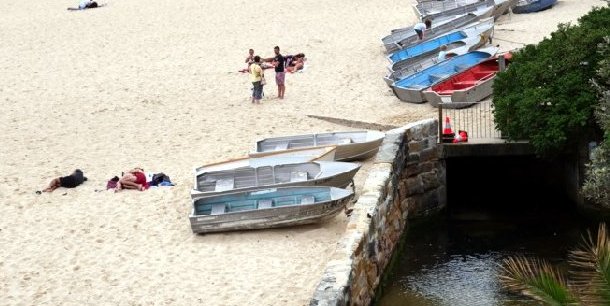
Stormwater Channels
Coogee's most notable stormwater channel or tunnel is the one that empties onto the northern side of the beach. It is what remains of a stream that ran from the
high gullies behind Coogee. The stream is now mainly enclosed in pipes and runs under Dolphin Street and emerges for about 50 metres as an open brick-sided
channel alongside the bowling greens of the Coogee Club, and then disappears underneath the Club buildings, continuing its journey west to the heights
behind Coogee. During rain storms, the channel can become a raging torrent. It has long been a concern that this stormwater channel is the source of
beach pollution; successive Coogee state members of Parliament have campaigned for the State Government to find a solution to the problem.
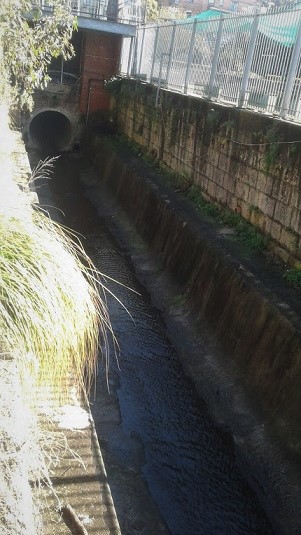
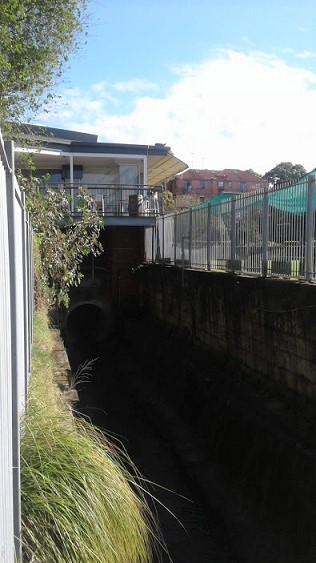
One stormwater channel empties into the ocean on the southern point of Coogee at Trenerry Reserve. Another empties into the ocean after emerging from underneath Coogee Surf Club. After heavy rain, water gushes from these two channels providing a spectacular waterfall-like displays.
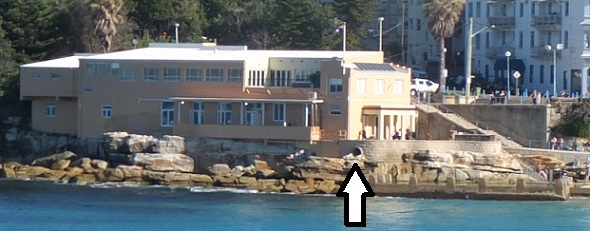
References
Copyright © Coogee Media All rights reserved
| CONTACT US | ABOUT US |